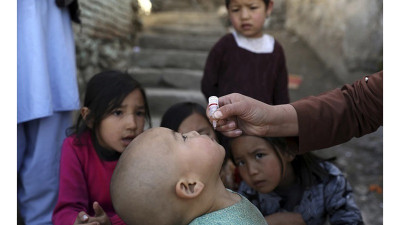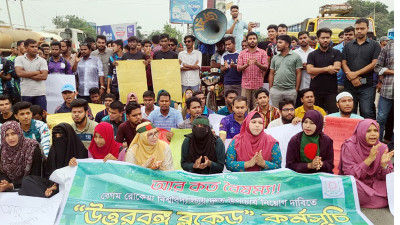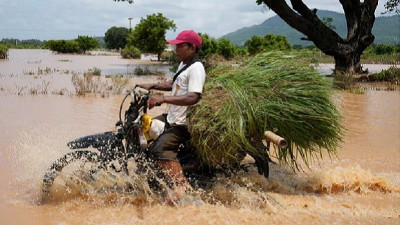 Photo: Bonik Barta
Photo: Bonik Barta Rangamati, a village in the border area of Feni's
Parshuram Upazila, has been devastated by the onslaught of water from upstream.
Everything has been swept away, and 5-7 feet of sand has covered the
agricultural land. There is now no trace of the road leading to this remote
area. Even after the floodwaters recede, residents are left nearly destitute,
having lost their homes and possessions.
Like Rangamati, hundreds of villages in Feni have been
submerged by floodwaters. Homes, roads, bridges, culverts, and countless other
infrastructures have been destroyed. This unprecedented flood has left fish
farmers, poultry entrepreneurs, livestock keepers, farmers, and small business
owners, among others, completely devastated. In addition to Feni, severe damage
has been reported in Noakhali, Lakshmipur, Cumilla, Chattogram, Khagrachari,
Moulvibazar, and Cox's Bazar. According to the international organization
Oxfam, the flood that began on August 20 has directly affected 5.8 million
people, with more than 5 lakh displaced. Infrastructure, homes, agriculture,
and fisheries have all been damaged. The affected populations urgently need
continuous humanitarian assistance to recover from these losses.
Although the government has yet to show any visible
initiatives for rehabilitating economic infrastructure damaged by the floods,
there has also been an extreme lack of coordination among government agencies
in delivering aid to the affected people. Residents of the damaged areas report
that various private initiatives have been active since the onset of the flood.
The military and other law enforcement agencies have played a role in rescuing
people stranded in the water and distributing relief. However, other government
institutions have remained limited in assessing the damage and affected
individuals feel that accurate information has not yet emerged.
Shahadat Hossain, the General Secretary of the Feni district
for Citizens for Good Governance (SHUJON), told Bonik Barta, "There have
been no initiatives from government agencies to rehabilitate the economic
infrastructure damaged by the flood. These institutions only focus on assessing
the damage. Many roads in Feni have become unusable due to the flood. Ordinary
people are trying to make the roads passable again through voluntary labor. We
have not heard of any government institutions assisting in this regard."
Shahadat Hossain noted that the Feni and greater Noakhali
region has many rivers. He said, "After the floodwaters receded, riverbank
erosion has intensified. The rivers are sweeping away roads, homes, and
agricultural land. Immediate action is needed to prevent further riverbank
erosion."
According to the Ministry of Disaster Management and
Relief, 68 upazilas across 11 districts have been inundated by floodwaters.
Affected are 5.306 million people across 504 unions and municipalities. So far,
71 deaths have been reported. On the other hand, Oxfam's data indicates that
Feni and Noakhali have been the most severely impacted by the flood. Over 90
percent of the population in these two districts has been critically affected.
About 48 percent of homes have been destroyed. Additionally, these two districts'
sanitation systems and access to potable water have become entirely
inoperative.
According to various government agencies, the damage in
the Feni district alone is estimated at least BDT 200 billion. As of Thursday
(September 5), 28 bodies had been recovered in the district. Dr. Mohammad
Mozammel Haque, the Feni District Livestock Officer, reported that the
floodwaters had killed 38 thousand cattle, 359 buffaloes, 16 thousand goats,
and millions of ducks and chickens.
According to the District Fisheries Office, 19 thousand
farms, including small and large ponds, have been submerged in all unions of
Feni. Describing the flood damage, Mohammad Ekram Uddin, Deputy Director of the
District Agricultural Extension Office, said, "In six upazilas of Feni, almost
all crops, including Aman seedbeds, Aman and Aush paddy, winter vegetables,
fruit orchards, ginger, turmeric, and sugarcane, have been washed away. Crops
on 38 thousand hectares of land have been destroyed. This has caused more than
BDT 52.5 billion in damage to 1 lakh 67 thousand farming families."
He noted that three to four feet of sand have accumulated
on thousands of hectares of agricultural land in the district. This will change
the classification of the land, reducing the amount of arable land, which could
adversely affect crop production in the district. A damage report has been
prepared and sent to higher authorities. Urgent rehabilitation measures for
farmers are necessary to maintain production.
Mahmud Al Faruk, Executive Engineer of the Local Government
Engineering Department in Feni, told Bonik Barta, "At least 500 kilometers
of rural roads in the district have been destroyed and are now unusable. If
these roads are not urgently repaired, it will be impossible to maintain the
supply chain. Repairing these roads will require at least BDT 10 billion. The
higher authorities have already been informed of the situation."
Feni District Commissioner Shahina Akhter reported that
the flood affected at least 1 million people. She told Bonik Barta, "The
flood has washed away hundreds of homes. Many villages in the district are
still underwater. Thousands of businesses have lost all their goods, leaving
many people destitute. If they are not urgently rehabilitated, various problems
will arise."
Due to the pressure of floodwaters and poor-quality
construction, the Musapur sluice gate (regulator) in Noakhali's Companiganj
Upazila collapsed on August 26. This regulator has 23 gates through which water
from the Muhuri River flows into the Bay of Bengal. Companiganj resident
Ehteshamuzzaman Asif reported that the collapse had allowed saline water from
the sea to enter the river during high tide. This has damaged agricultural land
and fish farming and intensified riverbank erosion. Thousands of people used
the road built over the regulator. No government initiatives have yet been
observed to repair other flood-damaged roads in the area.
According to the Lakshmipur District Administration, 18
thousand homes have been damaged. The disaster-affected population stands at 5
lakh 69 thousand 500. Currently, 32 thousand 519 people are residing in 417
shelters. Damage to the agricultural sector is estimated at BDT 22.7 billion,
to the water resources sector at BDT 86.5 million, and to the fisheries sector
at 2.4 billion taka. This has led to many farmers, fish farmers, and livestock
and poultry keepers being on the verge of homelessness.
District Relief and Rehabilitation Officer Md. Yunus Mia
reported that approximately 30 percent of Lakshmipur is still under water.
Preliminary data indicates that 18 thousand 365 homes have been partially
damaged by the floodwaters. However, rehabilitation efforts for the affected
individuals have not yet commenced.
According to the Local Government Engineering Department
(LGED) in Chattogram, 605 kilometers of roads have been damaged in the
flood-affected upazilas of the district. More than 125 small and large bridges
and culverts on these roads have been affected by the floodwaters. The most
damage has occurred in Fatikchhari and Mirsharai upazilas. Additionally, roads
in Hathazari, Banshkhali, Rauzan, Boalkhali, and several other upazilas have
also been damaged. The LGED department has estimated that repairing the damaged
roads will require at least 30 billion taka.
Mohammad Sayeduzzaman Sadek, Executive Engineer of the
LGED in Cumilla, said, "So far, 968 kilometers of our roads have been
submerged and damaged by the flood. Two bridges and 26 culverts have
collapsed."
Suniti Chakma, Executive Engineer of the Roads and
Highways Department (RHD) in Cumilla, said, "Approximately 100 kilometers
of national and regional highways have been damaged. Water has receded from
most of these roads except for a few. We are taking steps to repair the damaged
roads promptly."
District Relief and Rehabilitation Officer Md. Abed Ali
reported that several hundred kilometers of rural roads were damaged by this
severe flood. However, a complete list of the damaged roads has not yet been
finalized.
Meanwhile, officials from the Ministry of Finance have
stated that they have not yet received estimates from the relevant ministries
and departments regarding the extent of damage and the amount of funds required
for repairing the damaged infrastructure in the 11 flood-affected districts of
the eastern region. They have indicated that they will take steps to allocate
funds once the damage assessments are received.






